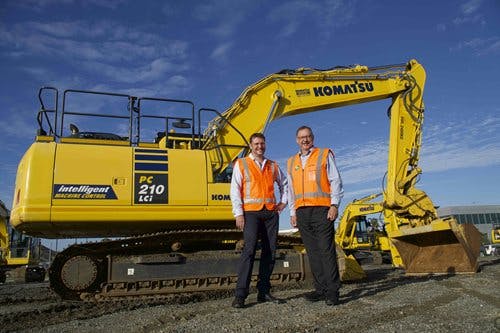Applying new digital technology and methods of working are set to bring the infrastructure sector simpler, safer and more efficient ways to progress, visualise and connect projects on and off site.
Advances in technology mean there are significant opportunities to drastically change the sector, enabling more work to be done for less while tackling the global skills labour shortage.
Environmental and Engineering consultancy Tonkin + Taylor is teaming up with Komatsu’s Smart Construction division to support this industry need.
Komatsu Smart Construction’s General Manager James Muir says that now, more than ever, the infrastructure and construction industry is ready for technology adoption and new methodologies to increase productivity, improve safety and remove time and material waste from construction.
“We’ve got an incredible amount of talent throughout the planning, design and construction stages of a project. The challenge is to better integrate this skillset with new technologies and data to improve productivity and decision-making,” says Muir.
Despite the construction industry contributing over $20 billion of GDP in New Zealand in 2019¹, the productivity of the sector continues to lag, with average annual productivity growth between 1994 and 2019 at 0.9%². This is particularly discouraging in comparison to the likes of the ICT and agriculture sectors, which had average annual productivity growth of 3.1% and 2.2% respectively².
To achieve better outcomes for productivity, says Muir, certain aspects across the construction project require attention.
“These include upskilling and enabling machine operators within the digital site; streamlining the design-to-construct process to remove inconsistencies between offsite design and on-site construction plans; providing greater accessibility to data to make sound decisions on-site without bias or opinion, and building trust within the digital “as-built” environment to improve work validation and cashflow,” says Muir.
“These are commonly known issues in our industry, voiced by contractors and clients alike.”
T+T’s Executive Leader Digital, Rekha Kharbanda says that digital technology is well equipped to help solve these significant productivity issues in infrastructure.
“We’re imagining a highly connected, transparent industry where machines can help keep their operators safe by working seamlessly with the site’s designs to automatically manage risks,” says Kharbanda.
“Where engineers are designing in software that communicates directly to the operator and machine carrying out the work. Where on and off-site engineers can collaborate in real-time to work through inconsistencies without having to significantly delay a project. And where there is one source of truth for all contractors, engineering consultants and clients to easily understand the site, the design and its risks at any stage of the project.
“Combining T+T’s digital design engineering strengths and access to complex client projects with Komatsu Smart Construction’s technologies and collaboration with industry experts will enable us to improve construction productivity using digitisation,” says Kharbanda.

(Left) Garth Dixon, National Sales Manager NZ New Equipment Construction (right) John Cooper, Principal Major Projects Delivery Specialist, T+T
“We’re looking to determine just how much of a difference can be made in this area so that the construction sector can improve the value chain.”
McKinsey research identifies seven key areas that could boost the construction sector’s productivity by 50-60 percent³, with T+T and Komatsu’s collaborative efforts looking to address 5 of them:
• Rethinking design ✓
• Improving onsite execution ✓
• Infusing technology and innovation ✓
• Reskilling workers ✓
• Improving procurement and supply chain ✓
• Reshaping regulation
• Rewriting contracts
Muir says that our industry and infrastructure owners are increasingly demanding that assets are planned, designed, constructed and maintained using a digital replica of the environment, or “Digital Twin”.
“Komatsu and T+T intend to be at the forefront of this advancement, and understand it’s critical to collaborate with our customers, communities, industry peers and colleagues to find better ways to deliver infrastructure projects quickly, safely and to a high standard,” says Muir.
“By looking at the bigger picture and utilising smart technology, we’re better able to serve the whole project at hand.”
“We’re looking forward to working with other construction industry leaders to pave this way forward.”
¹ https://www.stats.govt.nz/tools/which-industries-contributed-to-new-zealands-gdp#time-series
² https://www.branz.co.nz/documents/2760/ER56_Digital_product_data_LR12038.pdf
³ https://www.mckinsey.com/~/media/McKinsey/Business%20Functions/Operations/Our%20Insights/Reinventing%20construction%20through%20a%20productivity%20revolution/MGI-Reinventing-Construction-Executive-summary.pdf